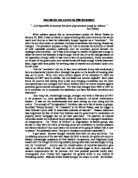How did the tsar survive the 1905 revolution?
How did the Tsar overcome the opposition they faced in the 1905 revolution? Many things where going against the Tsar at that time but was the main factor? It is thought to be one of three, the failing of the opposition, and the use of force and the makings of concessions. I will investigate these factors then come to conclusion on which factor was actually most influential.
The reason this revolution came about was because in the lead up to the actual opposition to the government there was increasing social unrest caused by rapid industrialisation: There was no way of the lower classes expressing their political views, there was no parliament for them, there was a discontented and oppressed working class, and a desperate and poverty stricken peasantry. The middle classes were unhappy because of the absence of being able to have a say in what was happening in their country, this was a problem for the vast population. The peasants were poor because they owned no land for themselves and of poor harvests and heavy taxing by the Tsar to pay for industrialisation. The working classes had to cope with very poor working conditions, for very long hours and for very little pay. This meant many of the classes where wanting the Tsars regime to come to an end. Only the gentry, the people who supported industrialisation and the army supported the regime.
Another problem the tsar caused was that it and his ministers believed that a victorious war would increase his popularity at home because it would give confidence to the people and would prove they were a successful regime they could trust. Because he thought this would improve his popularity he provoked Japan and eventually the rivalry over the control of Manchuria and Korea had become so intense that a war was unavoidable. On February 8 the Japanese attacked Russia; the Russo-Japanese War had begun. A quick, easy victory for the Russians was expected. But the Japanese at Port Arthur smashed the Russians Pacific Fleet, and a poorly equipped and badly led Russian army was heavily defeated in the important town of Mukden. Then the Baltic Fleet sailed to rescue a defeat by the Japanese but it was also destroyed in the battle. The Tsars optimism of this having a positive impact on the public’s view of them had completely failed; this had the complete opposite effect. The Russian people had given up a lot for this war. The railway system was used to keep the army supplied in the Far East. So in the cities the lack of transport led to food shortages and price rises. Factories had no access to raw materials, so they had to lay off workers or shut down. At the beginning of the war people were willing to support the war effort, but when news of defeat arrived they became disgruntled and demanded higher wages, the formation of trade unions and the abolishment of certain laws and a change in many issues revolving around the Tsar. On October 22 1905 the movement culminated in a march of thousands of industrial workers, men, women and children led by a priest and a union leader in the name of Father Gapon. They marched towards the Tsar's palace in St. Petersburg, carrying to peacefully present to him a petition that requested from him the improvement of living conditions, freedom of speech. The crowds where then asked to leave to leave, they wanted to stay and make sure their demands where heard and refused, the guards fired upon the peaceful protesters, resulting in the death of hundreds, and the wounding and trampling of thousands of people. These, in turn, sparked an endless number of proletarian strikes, peasant uprisings and seizures of land, mutinies in the army and the navy as well as further opposition to the Tsar and everything it stood for, especially by the Union of Liberation and the national minorities. The peasants had had a great deal of respect for the Tsar. The Tsar was the leader of their church and he was a father like figure for them. After Bloody Sunday incident this image of him was shattered. Even though the Tsar was not present at the Winter Palace, the people believed he was and that he had given the order to fire upon them.







